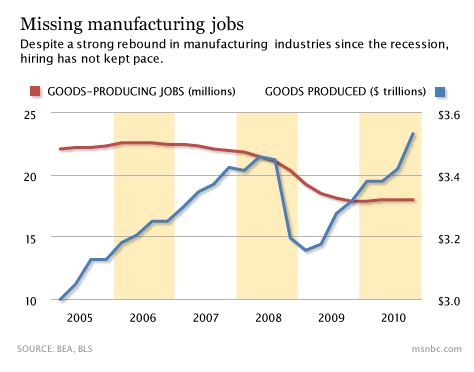US unemployment - another look
The US economy seems to be recovering from several perspectives. US corporate profits are up and the DJIA closed at 12,391 on February 18; up from below 10,000 in July 2010. According to the Wall Street Journal, US new car sales are up about 17 percent (January 2010 vs. January 2011) and, according to Bloomberg, S&P 500 US companies have $1.18 trillion in cash on hand. So, why is it that US unemployment remains unacceptably high? Much of the answer can be seen in the graph below.

The value of US produced goods has now exceeded the peak before the financial crisis; however, the level of manufacturing jobs has not increased from the lows of 2009-10. These two trends mean the workers that still have jobs are more productive than ever and that many low skilled jobs will never come back. As a matter of fact, on February 3, the US Department of Labor announced non-farm output per hour worked increased by 2.6 percent, on an annual basis, during last three months of 2010. This statistic coupled with the slightly improved, but still alarming, unemployment rate of 9.0 percent for January 2011, gives us reason to revisit several aspects of unemployment.
Recall that structural unemployment is caused by those seeking work but not having the required skills, training or education to do the work the economy calls for – a mismatch between workers' abilities and the available jobs. I argue that much of the unemployment during the preceding year or so has been structural unemployment which is the most difficult for policy makers to reduce. The two statistics above confirm that the U.S. is facing serious structural unemployment. However, we should also consider the other two types of unemployment – frictional and cyclical.
Frictional unemployment is caused by new workers entering the job market and taking several weeks or months to find a job. Another source of this type of unemployment is workers changing jobs. Therefore, a reasonable amount of frictional unemployment is considered normal and even a good thing.
Cyclical unemployment comes from downturns in the economy. It differs from structural unemployment because these lost jobs will eventually come back when the economy recovers. Even so, cyclical unemployment is serious and it too is considered damaging to the economy because policy makers do not know how and when an economic recovery will occur. In the meantime, workers idled because of a business cycle downturn suffer just as much as the structurally unemployed.
There is probably still some more cyclical unemployment remaining in the 9.0 percent January US unemployment figure. But the evidence suggests many unemployed people in the U.S. will never be able to do their previous jobs again. Therefore, in order to include all people in an economic recovery, the U.S. needs to reeducate and retrain its work force. This, in conjunction with deciding what the US can produce and sell at attractive world prices, has never been more important.
The author is a columnist with China.org.cn. For more information please visit: http://www.china.org.cn/opinion/node_7078635.htm
Opinion articles reflect the views of their authors, not necessarily those of China.org.cn
 0
0 







Go to Forum >>0 Comments